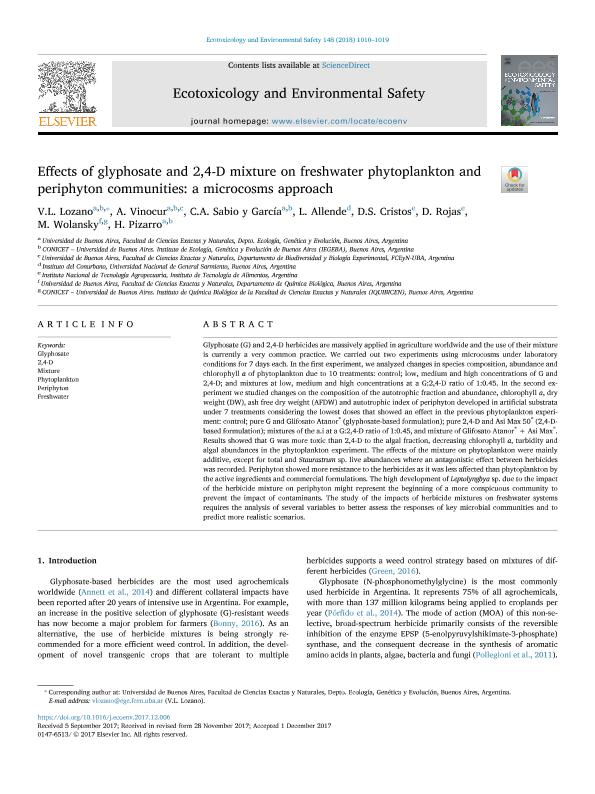Artículo
Effects of glyphosate and 2,4-D mixture on freshwater phytoplankton and periphyton communities: a microcosms approach
Lozano, Verónica Laura ; Vinocur, Alicia Liliana; Sabio y García, Carmen Alejandra
; Vinocur, Alicia Liliana; Sabio y García, Carmen Alejandra ; Allende, Luz
; Allende, Luz ; Cristos, Diego Sebastián; Rojas, D.; Wolansky, Marcelo Javier
; Cristos, Diego Sebastián; Rojas, D.; Wolansky, Marcelo Javier ; Pizarro, Haydee Norma
; Pizarro, Haydee Norma
 ; Vinocur, Alicia Liliana; Sabio y García, Carmen Alejandra
; Vinocur, Alicia Liliana; Sabio y García, Carmen Alejandra ; Allende, Luz
; Allende, Luz ; Cristos, Diego Sebastián; Rojas, D.; Wolansky, Marcelo Javier
; Cristos, Diego Sebastián; Rojas, D.; Wolansky, Marcelo Javier ; Pizarro, Haydee Norma
; Pizarro, Haydee Norma
Fecha de publicación:
12/2017
Editorial:
Academic Press Inc Elsevier Science
Revista:
Ecotoxicology and Environmental Safety
ISSN:
0147-6513
Idioma:
Inglés
Tipo de recurso:
Artículo publicado
Clasificación temática:
Resumen
Glyphosate (G) and 2,4-D herbicides are massively applied in agriculture worldwide and the use of their mixture is currently a very common practice. We carried out two experiments using microcosms under laboratory conditions for 7 days each. In the first experiment, we analyzed changes in species composition, abundance and chlorophyll a of phytoplankton due to 10 treatments: control; low, medium and high concentrations of G and 2,4-D; and mixtures at low, medium and high concentrations at a G:2,4-D ratio of 1:0.45. In the second experiment we studied changes on the composition of the autotrophic fraction and abundance, chlorophyll a, dry weight (DW), ash free dry weight (AFDW) and autotrophic index of periphyton developed in artificial substrata under 7 treatments considering the lowest doses that showed an effect in the previous phytoplankton experiment: control; pure G and Glifosato Atanor® (glyphosate-based formulation); pure 2,4-D and Asi Max 50® (2,4-D-based formulation); mixtures of the a.i at a G:2,4-D ratio of 1:0.45, and mixture of Glifosato Atanor® + Asi Max®. Results showed that G was more toxic than 2,4-D to the algal fraction, decreasing chlorophyll a, turbidity and algal abundances in the phytoplankton experiment. The effects of the mixture on phytoplankton were mainly additive, except for total and Staurastrum sp. live abundances where an antagonistic effect between herbicides was recorded. Periphyton showed more resistance to the herbicides as it was less affected than phytoplankton by the active ingredients and commercial formulations. The high development of Leptolyngbya sp. due to the impact of the herbicide mixture on periphyton might represent the beginning of a more conspicuous community to prevent the impact of contaminants. The study of the impacts of herbicide mixtures on freshwater systems requires the analysis of several variables to better assess the responses of key microbial communities and to predict more realistic scenarios.
Palabras clave:
2,4-D
,
Freshwater
,
Glyphosate
,
Mixture
,
Periphyton
,
Phytoplankton
Archivos asociados
Licencia
Identificadores
Colecciones
Articulos(IEGEBA)
Articulos de INSTITUTO DE ECOLOGIA, GENETICA Y EVOLUCION DE BS. AS
Articulos de INSTITUTO DE ECOLOGIA, GENETICA Y EVOLUCION DE BS. AS
Articulos(IQUIBICEN)
Articulos de INSTITUTO DE QUIMICA BIOLOGICA DE LA FACULTAD DE CS. EXACTAS Y NATURALES
Articulos de INSTITUTO DE QUIMICA BIOLOGICA DE LA FACULTAD DE CS. EXACTAS Y NATURALES
Citación
Lozano, Verónica Laura; Vinocur, Alicia Liliana; Sabio y García, Carmen Alejandra; Allende, Luz; Cristos, Diego Sebastián; et al.; Effects of glyphosate and 2,4-D mixture on freshwater phytoplankton and periphyton communities: a microcosms approach; Academic Press Inc Elsevier Science; Ecotoxicology and Environmental Safety; 148; 12-2017; 1110-1119
Compartir
Altmétricas



